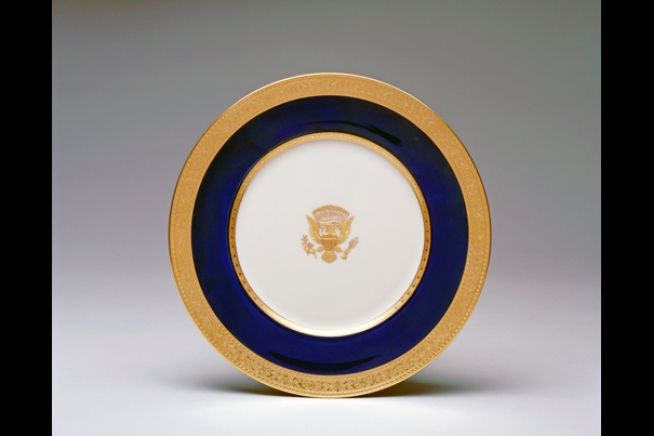
The White House has always held a special fascination, not so much for particular occupants, but because the President’s house is the first home of Americans. Built and furnished largely with public funds, the White House has seen many furnishings come and go. According to the United States Appropriation Act of 1826, all furnishings were purchased with public funds and were to be made in America “as far as practicable.” These four little words allowed for plenty of “slippage” when it came to White House china. Most of it was made abroad in the 19th century because no American manufacturer had been found who could make a service of the size and quality required for White House entertaining. When Mrs. Theodore Roosevelt went looking for an American vendor, she settled on England’s Wedgwood. This service continued to be used during the administrations of Roosevelt and Taft and the first term of Woodrow Wilson.
During his first term, Wilson’s first wife Ellen died and he later married Edith Bolling Galt, who was also widowed when they met in 1914. Her husband had been in the jewelry and silver business in Washington until his untimely death. So it was mostly out of courtesy that the china dealers, Dulin & Martin, old professional friends of Edith Bolling Galt (now Wilson), invited her to visit their special exhibit of Lenox China in 1917. After showing Mrs. Wilson through the display, Lenox’s representative Charles Service mentioned discreetly that if the Wilsons were interested in buying new china for the White House, Lenox would like to be considered for the commission.
At the time, the Commission of Fine Arts, created in 1910 to oversee the furnishing of the White House, had be notified by Col. William Harts, the commissioner of public buildings and grounds and by virtue of this position secretary of the Commission as well, that new china was needed. He enlisted the help of Commission member William Kendall of New York, who chose to work with Tiffany’s. Kendall found no plates that matched the ideas expressed by Mrs. Wilson. He did, however, pick out a plate that could provide a starting point and Tiffany’s George Kunz suggested that the President’s special seal might be featured. Tiffany’s presented several designs to be executed in French porcelain, but none fulfilled the expectations of the President and First Lady.
In considering a new pattern for the White House, the Wilsons were particularly keen to have something that was patriotic, because of the war in Europe, and agreed that the Great Seal should be the principal motif. The Wilsons also asked for the use of a cream-colored border, but communication between Tiffany’s and the Commission broke down as a new vendor surfaced. By inviting Mrs. Wilson to their showroom exhibit of Lenox china, Dulin & Martin had promoted an alternate source that was American. And the President’s previous appointment as President of Princeton University and later election as Governor of New Jersey predisposed him to favor a New Jersey company, whose owners were well-known to him.
In the final design, the Great Seal is displayed on a cream-colored border enclosed by gold bands on the various table forms. It is centered on the service plate and rendered elegantly and meticulously in raised gold paste set off by a brilliant sapphire blue and gold border. Frank Holmes’s design was perfectly suited to the purpose and period and surely appealed to Mrs. Wilson’s taste for fine jewelry. The administrations of Warren Harding, Calvin Coolidge, and Herbert Hoover continued to order replacements. The first American-made service set a new standard for White House china, and Lenox became the principal purveyor of china to the White House in the 20th century.
